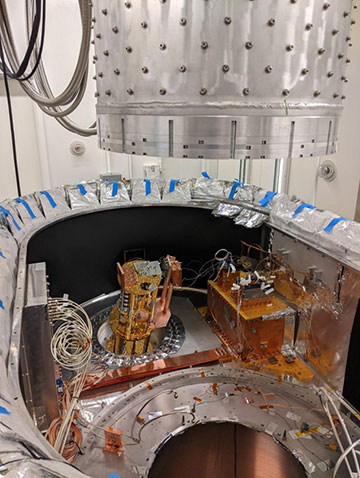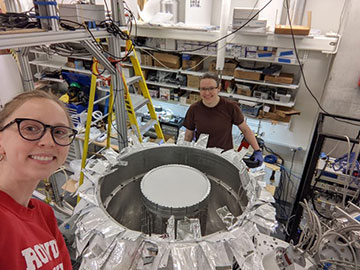
Researchers developed a way to use radio holography to characterize a fully integrated cryogenic-telescope instrument prior to deployment. To place the telescope optics in the tester, the optics tube enters the cryostat from below, where it is secured in place. Then, the entire cryostat is flipped so that the window points upward. [Image: G. Chesmore, University of Chicago]
Before attempting to measure a signal as faint as the cosmic microwave background (CMB), scientists must ensure that they fully understand their instrument’s performance. The detector team for a new ground-based telescope dedicated to CMB research has now used a technique called radio holography to predict the on-sky performance of the millimeter-wave detector while it was still in the laboratory (Appl. Opt., doi: 10.1364/AO.470138).
The US-based tests enabled the researchers to map the telescope’s optical response in a cryogenic environment—the same temperature at which the detector will operate. Most laboratory calibration techniques are too cumbersome to be performed in a cooling chamber.
A telescope with optical innovations
The millimeter-wave detector is destined for the Large Aperture Telescope (LAT) at the Simons Observatory, a multinational consortium dedicated to studying the CMB from a base in northern Chile’s Atacama Desert. The observatory “aims to characterize the anisotropies and the polarization of the CMB at a multitude of angular scales and at unprecedented sensitivity,” says Grace Chesmore, a doctoral candidate at the University of Chicago, USA, and a member of the Simons research team.
The 6-m-aperture LAT boasts an innovative architecture called “crossed Dragone,” an off-axis design with a parabolic primary mirror and a comparatively large concave secondary mirror, with the focal plane perpendicular to the incoming light to preserve its polarization. The unusual structure provides the LAT with a wide aperture for small angular resolution with coma-corrected mirrors, according to Chesmore. The observatory will also feature baffles made of metamaterials specifically designed to suppress stray microwave radiation.
Optics tubes for different frequencies
According to Chesmore, cosmologists measure the beam of their telescope by measuring a planet or any object smaller than the telescopes’ resolution. Scientists then take the beam measurements into account when analyzing the tiny fluctuations in CMB radiation.
The LAT’s detector consists of 13 optics tubes, each packed full of lenses, infrared-blocking filters, low-pass edge filters and transition-edge sensor bolometers. Together, the tubes will fill the roughly 2-m-wide focal plane inside the receiver, but they will be tuned to low, midrange and high frequencies in the range from 80 to 170 GHz. During operations, all the optical elements will be kept at temperatures between 100 mK and 4 K.

Two members of the research team, Grace Chesmore (left) and Katie Harrington (right), open the front of the tester used to analyze the Simons Observatory Large Aperture Telescope receiver optics. [Image: G. Chesmore, University of Chicago]
To accommodate the individual optics tubes, the University of Chicago collaborators built a test cryostat approximately 2 m tall. Since materials expand and contract with temperature changes, the researchers wanted to measure the sensitivity parameters and systematic errors of each device at the actual operating temperature, not at room temperature.
Unlike other techniques for characterizing radio beams—measuring just the wavefront’s magnitudes or its amplitude and phase—the Chicago group employed near-field holography to study the wavefront emerging from the back end of each optics tube. The process helped predict the expected beam pattern once the receiver in installed at the LAT. The holographic measurements led the team to remove a filter from each tube for greater optical efficiency.
From near field to far field
One of the biggest challenges in characterizing the detector optics was projecting the near-field measurements into the far field. Chesmore developed a ray-tracing Python package employing Fourier optics to accomplish this task. “This required careful optical design in the software, to ensure the near-fields project off of the 6-m mirrors and into the far field,” she says. The open-source software has been posted online and can be adapted for other millimeter-wave and radio telescopes.
The optics tubes are on their way to northern Chile, a region which hosts several other observatories for millimeter, submillimeter and far-infrared astronomy. According to Chesmore, LAT is scheduled for first light in January or February of 2023.
